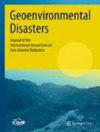膨润土和粘土对垃圾填埋场渗滤液中锌(II)的吸附性能
IF 4
Q2 ENVIRONMENTAL SCIENCES
引用次数: 0
摘要
镀锌和干电池行业的日益盛行导致垃圾填埋场中锌的比例上升,带来了环境风险。膨润土以其金属吸附能力而闻名,本研究探讨了膨润土作为垃圾填埋场隔离材料的潜力。研究了 Zn(II)在天然膨润土和上海粘土中的吸附特性。通过间歇式吸附试验分析了影响 Zn(II)吸附的各种因素,包括 pH 值、Na 离子强度、接触时间、初始 Zn(II)浓度和吸附温度。结果表明,pH 值和 Na 离子强度的变化对 Zn(II)在膨润土上的吸附没有显著影响,这突出表明了膨润土对 Zn(II)的强选择性。相反,Zn(II)在粘土上的平衡吸附容量会随着 pH 值的升高或离子强度的降低而增加。伪二阶模型、颗粒内扩散模型和 Elovih 模型都很好地描述了 Zn(II)在膨润土上的吸附,每个模型的 R2 值都超过了 0.9。虽然 Zn(II)在膨润土或粘土上的吸附同时存在物理吸附和化学吸附,但决定吸附速率的主要因素是化学吸附。在膨润土上的吸附是自发的,而在粘土上则不是。Zn(II)在膨润土和粘土上的吸附机理包括范德华力、离子交换和化学作用,例如内球络合。本文章由计算机程序翻译,如有差异,请以英文原文为准。
Adsorption performance of bentonite and clay for Zn(II) in landfill leachate
The increasing prevalence of the Galvanized and dry battery industries has led to a rise in zinc proportions in landfills, posing environmental risks. This study explores the potential of bentonite, renowned for its metal adsorption capability, as a landfill barrier material. Adsorption characteristics of Zn(II) in natural bentonite and Shanghai clay were investigated. Various factors affecting Zn(II) adsorption, including pH, Na ion strength, contact time, initial Zn(II) concentration, and adsorption temperature, were analyzed through batch-type adsorption tests. The change in pH and Na strength demonstrates no significant impact on the adsorption of Zn(II) onto bentonite, highlighting the strong selectivity of bentonite for Zn(II). Conversely, the equilibrium adsorption capacity of Zn(II) onto clay increases with rising pH or decreasing ion strength. The Zn(II) adsorption onto bentonite is well-described by the pseudo-second-order, intra-particle diffusion, and Elovih models, each achieving an R2 value exceeding 0.9. While both physical and chemical adsorption coexist in Zn(II) adsorption onto bentonite or clay, the primary determinant of the adsorption rate is chemical adsorption. The adsorption onto bentonite is spontaneous, whereas onto clay it is not. The mechanism involves van der Waals forces, ion exchange, and chemical actions such as inner-sphere complexation for Zn(II) adsorption onto both bentonite and clay.
求助全文
通过发布文献求助,成功后即可免费获取论文全文。
去求助
来源期刊

Geoenvironmental Disasters
Social Sciences-Geography, Planning and Development
CiteScore
8.90
自引率
6.20%
发文量
22
期刊介绍:
Geoenvironmental Disasters is an international journal with a focus on multi-disciplinary applied and fundamental research and the effects and impacts on infrastructure, society and the environment of geoenvironmental disasters triggered by various types of geo-hazards (e.g. earthquakes, volcanic activity, landslides, tsunamis, intensive erosion and hydro-meteorological events).
The integrated study of Geoenvironmental Disasters is an emerging and composite field of research interfacing with areas traditionally within civil engineering, earth sciences, atmospheric sciences and the life sciences. It centers on the interactions within and between the Earth''s ground, air and water environments, all of which are affected by climate, geological, morphological and anthropological processes; and biological and ecological cycles. Disasters are dynamic forces which can change the Earth pervasively, rapidly, or abruptly, and which can generate lasting effects on the natural and built environments.
The journal publishes research papers, case studies and quick reports of recent geoenvironmental disasters, review papers and technical reports of various geoenvironmental disaster-related case studies. The focus on case studies and quick reports of recent geoenvironmental disasters helps to advance the practical understanding of geoenvironmental disasters and to inform future research priorities; they are a major component of the journal. The journal aims for the rapid publication of research papers at a high scientific level. The journal welcomes proposals for special issues reflecting the trends in geoenvironmental disaster reduction and monothematic issues. Researchers and practitioners are encouraged to submit original, unpublished contributions.
 求助内容:
求助内容: 应助结果提醒方式:
应助结果提醒方式:


